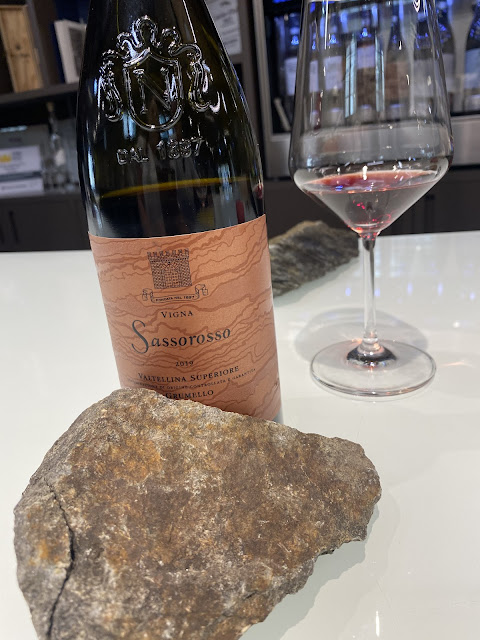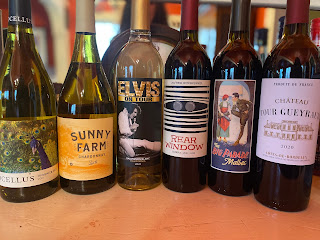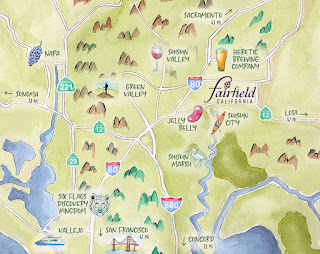Another extraordinary off the radar DOCG. No, TWO DOCG’s! The Valtellina Valley.
 |
| Along the drive heading north- Lake Como |
 |
| View of Sondrio, Valtellina Valley |
Driving a little further north, after leaving our wine conference in the Lake Garda area, but still in Lombardy, we pass Lake Como, head up in elevation, and as we ascend the road narrows and the landscape makes it obvious we are in a alpine world. After about 2 hours we reach the top of the Valtellina Valley. Our driver stops and lets us hop out to enjoy the view of Sondrio below, and take a moment to give a hint of what’s to come. Everyone is stunned and busy snapping photos.
 |
| Vineyard from the valley floor. Zoom in to see UNESCO world heritage site walls going all the way up the steep slope. |
After descending down to the valley floor, I AM floored. UNESCO heritage stone terraces reaching up the heights of these stunning montagnas. These stone walls, dug of this earth, are the only way viticulture, or any farming could exist here. The stones walls are from the Roman Middle Ages, built by hand of rocks found in the soil, found there as a result of the collision of two plates- the African with the European. This crash formed the Alps and the 3000-5000 meter high valley mountains millennia ago.


Over the next two days, we have a chance to soak in lots of the local culture. Our cozy hotel room gives us a bird’s eye view of the Valtellina Valley, and the mountains beyond. We eat bresaola made here from the local livestock, and it not only has virtually no fat, but against intuition is so tender it melts in your mouth- (unlike when its packaged and shipped). We gorge on several types of pasta, one made from locally grown rye, as well as the buckwheat and local cheese pasta called pizzoccheri. We visit ruins of a castle, we sample wines in caves, dine in an old stone farmhouse, and walk in the captivating square of the town of Sondrio at the center of this paradise.
 |
| Ar.Pe.Pe’s Isabel Pelizzatti Perago |
 |
| Selection of local Valtellina fare |
 |
| Fresh bresaola, and buckwheat & beer battered Sciat |
 |
| Night view from our hotel balcony. See the brightest light, in the center left ? That is the largest church in the area. There are many, many churches in the valley. During a time of conflict, the pope sent many priests to the area, to keep the Protestants from the north out. It worked. |
 |
| Our balcony overlooking the valley |
 |
| Hotel dining |
 |
| Local wines |
 |
| Pizzocceri - pasta made of local buckwheat flour, with potatoes, cabbage, and Casera cheese. The cows traditionally came down from grazing on the mountain slopes in warm months, to munch on hay on the valley pastures in the winter, giving the Casera a sweet, milky flavor. Bitto cheese is made in the summer, from the mountain grass fed cows. |
 |
| Another shot from our hotel room |
 |
| Along my morning walk |
 |
| Loads more local wine |
 |
Dining room in our hotel
|
We also climb the steep slopes to witness harvest, but are stopped short because our footwear is not cleated - they’d rather not lose a wine writer and her husband to this impossibly steep mountain side! I am immediately reminded of Mosel, Germany, even though I’ve only seen photos, of similarly traitorous slopes covered in Riesling vines.
 |
| Amphora room at Cantina Involt Agnolot |
 |
| I'd always known Nebbiolo to take its name after nebbia, the fog that consumes the areas in Piedmonte (the best known place for Nebbiolo production- famously Barolo), in which it thrives, at time of harvest. Danilo Drocco the president of the consortia of wineries in the Valtellina, shares that here, it is the nebbia that that covers the grapes skin when it is ripe that gives the name. |
 |
| Geology exposed. Castel Grumelo was built on this bedrock resulting from the collision of tectonic plates. |
 |
| Inside the residence at Castel Grumelo |
 |
| Residential portion of Castel Grumelo |
 |
| Military section of Castel Grumelo |
 |
| Amphora Cellar |
 |
| Amphora, Cantina Involt Agnolot |
 |
| A cable and pulley system is used to bring the grapes down the mountain after harvesting. Bet you can't spot the men way up on the slope picking grapes! Vineyards that don't employ the pulley system, grape pickers must carry the grape down on their backs, and let me remind you- this is steep! |
 |
| Maybe you can see them here ;) |
Two DOCG’s reside here. The Valtellina Superiore, and Sforzato (Sfurzat) di Valtellina. Both fermented from the local Nebbiolo- here called Chiavennasca . With a different expression here than the Nebbiolo in Barolo, these wines are more approachable- fresher, cherry scented with softer tannins, ready to drink, but also quite age worthy. Sfurzat di Valtellina DOCG has been around longer (2004), than the more famous Amarone di Valpolicella DOCG (2010) to the southeast, and made in a similar way. The grapes for the Sforzato are dried (appasimento), after harvest, (usually for 30-60 days), loosing 30-40% of their water weight and concentrating the flavors. The vinification here is different than in Barolo too, not extracting the same level of tannins from the skins, all resulting in a fresher, more approachable wine.

 |
| Examples of three wines from different crus/vineyards of Cantina Nino Negri. They display unique characteristics, partially from the different coloured stone (mineral variation) in the vineyard. |
 |
| Nino Negri's flagship wine - 5 Stella Sfursat, made from the best of the plots, with about 100 days of apassiamento before vinification |
The “sunny side” of the mountain, as it is refered to here, provides lots of sunny days, more than Barolo, (as much as Sicily!) but night time temps fortuitously swing way down, preserving the acidity that keeps the liquid treasure of this valley lively and age-worthy.
This region was taken over by what is now Switzerland (Graubünden) in the 1500’s, and basically for the next 300 years, the Swiss soaked up the beauty, and had their best vineyards here, until Napoleon brokered it to Italy. Some in the Swiss canton still dream of annexing the Valtellina Valley, or merging with Lombardy into a new country. I can see what attracts them!
 |
| Time for lunch, but first: wine! Cantina Involt Agnelot wine selection. They make only 3 wines, and the grapes from each wine comes from a different level on the mountain. The higher up the slope you go, the more stone in the ground, giving the wine more "lift". Clay dominates at the lowest level. Their wines are made in a “modern” style, outside of the rules of the DOCG, without any wood treatment. This is a smart move for them, as their wines show the pure fruit and express the terroir of this magnificent valley. They are aged in terracotta amphora, seen above. Care is taken to stay away from chemical herbicides and pesticides, and they use minimal sulfur. Involt is one of the smallest and newest wineries here, their first release of the 2013 vintage not until 2020. |
 |
| Our server at Ristorante Fracia |
 |
| Nephew of founder of Cantina Involt Agnolot shares his grappa, distilled in a beautiful copper still, from grape skins at the distillery room in the cantina. |
 |
| I mean, look at that view! Glimpsing the other side of the valley from Fracia |
 |
| The nickname of the family Agnelot comes from the familial trait of curly hair - like a lamb |
 |
| Lunch at Ristorante Fracia. Tagliatelle pasta made from alpine rye with the freshest darn chanterelles I’ve ever had. Exquisite. We also scarfed some bread made with that rye. This was my most memorable, and favorite meal in Lombardy, with these two local winemakers. |
 |
| Prosciutto they called raw, I think they meant uncured. It was so tender with the chanterelles |
 |
| Interior Ristorante Fracia. This building was originally the stone farmhouse where the grape drying/appassimento, was done for Valtellina Sforzato DOCG. |
 |
| Wine bottle collection at Fracia |
 |
| Patio seating at Fracia |
 |
| What lies around the bend? |
 |
| Town square - Sondrio |
 |
| Caves that are several stories underground, lie beneath the streets of Sondrio. They now provide a hidden, but grand wine tasting venue, as well as a classroom area. |
 |
| Town square |
 |
| Public art in Sondrio |
 |
| See the steepness of the slope behind Danilo? |
 |
| Succulents growing in the rock belie the heat of the days, while the white lichen on the rock, helps to transfer the mineral of the stone to the vine/wine. |
Consider a visit to this little known wine region of Valtellina Valley. In addition to the spectacular vistas, food and wine, this place is known for its hot springs and world class skiing in the winter, which I hope to return to take advantage of some day!
Ciao, and thanks for reading!























































I love that you show us the ruins of the Castel Grumello! You have some amazing photographs! It was interesting to see behind the scenes at Nino Negri and Involt Agnelot!
ReplyDeletethanks so much!
Delete